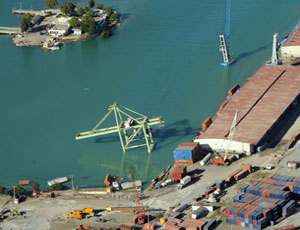The Jan. 12 quake that struck Haiti made a shambles of the cargo-handling facilities of the port of Port-au-Prince, a U.S. Coast Guard assessment team reported late Friday. The port, which faces the Caribbean Sea and the eastern tip of Cuba about 175 miles to the west, includes cranes, large berths, and warehouses. The Coast Guard and U.S. Navy are trying to see what will have to be done to get it back in service to assist in the delivery of aid.

The team said five cargo cranes are damaged, unstable or submerged. The harbor is choked with sunken shipping containers and large amounts of debris.
The Coast Guard was one of the first responders on the scene. A spokesman says when Coast Guard personnel arrived they found oil and sewage spills spreading up to a mile-and-a-half from the coast and many small fires burning on the shoreline. He said the Coast Guard is working with the U.S. Navy on the initial effort to reopen the harbor, and he expects contractors will be brought in later to help rebuild. The assessment team also is investigating neighboring ports to see if other options are be available in the near term. Until the ports are reopened, the Coast Guard is airlifting relief supplies to the shore.
While speeding to the scene, the aircraft carrier USS Carl Vinson arrived off the port on Friday loaded with 19 helicopters, personnel and support equipment it picked up from five different East Coast Navy squadrons. In a press conference in Washington, D.C. on Friday, P.J. Crowley, an assistant secretary of state and a spokesman at the U.S. State Dept., said “as the Vinson was steaming south, they were bringing its complement of aircraft off and putting helicopters on. So in essence, with the arrival of the carrier, that gives you a second airport.”
Crowley said that means the flow of water, food, medical supplies and other gear should begin to increase, especially as roads are cleared in inland areas.
With respect to the port itself, he said “the limitation right now is the inherent infrastructure in Haiti. We’d love to have access to the port...but for the moment, for large ships, the port is unusable.”
In Washington, D.C., pledges of support were gaining backers.
U.S. House of Representatives Majority Whip James E. Clyburn (D-S.C.) told reporters that he is pleased that the Obama administration has agreed to immediately invest $100 million in relief funds. “We will follow here in Congress with a response as well,” he said. Although he did not spell out any specifics, he said it would be a package put together by himself and other Democratic leaders, including House Ways and Means Chairman Charles Rangel (D-N.Y.).
One component of the package being considered would include a measure to allow Americans to count any cash donations made to the relief effort in Haiti as deductible on 2009 tax returns, he said.
House Speaker Nancy Pelosi observed that the relief effort may bring about “an opportunity for a real boom economy in Haiti” and allow the country to get a “fresh start: with new buildings and infrastructure.
The U.S. Agency for International Development reported that it had identified four major water purification systems, plus the water purification and production capacities of the military assets—the ships that will be there. Another six water purification systems could also be called in, and USAID is already tapping its worldwide system of storage and warehouse facilities for other supplies.
USAID is in mobilizing 100,000 10-liter, collapsible containers people to use to collect and transport water.
Already on the ground before the quake, and now engaged in relief work, is 250-person military engineering unit from Brazil. It had been serving there with the United Nations stabilization force and is now helping with rescue efforts at the collapsed building serving as the U.N. headquarters in Port-au-Prince. Susanna Malcorra, the United Nations Undersecretary-General for Field Support, told the Associated Press that the crew lacks sensors and search-and-rescue equipment and must be careful not to inflict additional damage on the building.
Industry resources, for the most part, are pledging donations and lining up with offers to assist, but standing by to await calls to action. A raft of individuals with expertise has begun signaling their availability and desire to help at a blogsite of ENR Editor-in-Chief Jan Tuchman.


Post a comment to this article
Report Abusive Comment